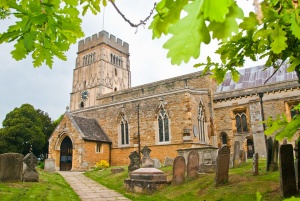
All Saints church in the Northamptonshire village of Earls Barton is one of the most fascinating historic churches in the county, with a marvellous Saxon tower and later Norman and early medieval features.
It is the 10th-century tower that draws most visitors to Earls Barton, and it is easy to see why. The rich Saxon stonework and carving detail is exquisite, certainly making the tower one of the best examples of Saxon architecture in England today. Betjeman calls it 'a work redolent of all that is best in the Anglo-Saxon tradition', and I'd have to agree.
It is possible that the church was private, that is, built by a wealthy Saxon landowner beside his dwelling. We know that in 1066 Earls Barton was held by a lord named Bondi, so it seems likely that the church was built by one of his immediate predecessors as lord of Earls Barton.
We know that Bondi was also lord of Barnack, and that stone from the famed quarries at Barnack was used in the construction of All Saints church. It is possible that the workmen who built the church came here from rebuilding the abbey of Medeshamstede (Peterborough) in AD 959.
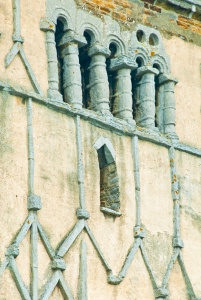
The Saxon Tower
The tower of All Saints was built around 970AD. It is all that remains of a turriform church; that is, a church formed entirely of a tower with an eastern extension serving as a chancel, or sanctuary. The ground floor of the tower was the church nave, where the worshippers stood (they did not sit, for pews were unknown).
Turriform churches are rare after the Norman Conquest, and very few have survived unaltered. Though the eastern extension with its characteristic high roof is gone, the original Saxon tower remains. If you stand near the church gate and look at the tower you can see the outline of the original chancel roofline.
Around 1180 the current nave and chancel were added to the tower to create the building we see today. This was probably done by Simon de St Luz (or Senlis) the Earl of Northampton. Senlis also built Delapre Abbey in Northampton, and Delapre held the patronage of Earls Barton until the Reformation.
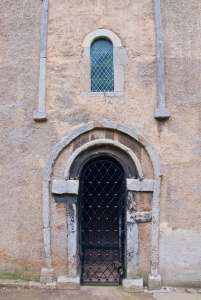
The tower is a quite remarkable structure in its own right. For a start, the foundations are only 8-12 inches thick (roughly 20-30cm). The original Saxon construction has survived to a height of over 63 feet (19 metres); the height of the battlements. The original tower probably had a pyramidal roof.
The most obvious features of the tower are wonderful long-and-short quoins and a profusion of pilaster strips (long, thin strips of stone). Though these look like purely decorative features, they are actually essential parts of the construction, extending from 10-40cm into the wall. They look for all the world like a stone version of medieval timber-framing. It is possible that they were meant to represent in stone the half-timbered look of an earlier timber tower.
High up on the south tower face is an incised cross in a circular background. This is likely a consecration cross, but it is very unusual to see one set so high on the tower like this. It was customary when a church was dedicated to have a dozen carved crosses on the outside and a dozen painted crosses inside the church.
Look closely at the west door and you will see that it is built on thick slabs placed on end, extending through the thickness of the wall. At the spring course level (below the doorway arch) are horizontal blocks decorated with miniature arcading. This decorative arcade carving is thought to be unique among English Saxon churches.
Another unique feature to Earls Barton is the multiple light belfry openings, found here on every face of the tower. It is very rare for a Saxon tower to have belfry openings on every side, and suggests that Earls Barton always had bells in the tower. On the east face are a pair of curious round holes. These are called 'sounding holes' but historians are not really sure what their purpose was.
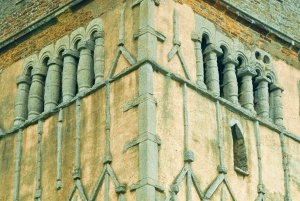
Note the mix of rounded and pointed Saxon window openings. The pointed windows (found on all four faces of the towers) may have been used for lookout posts. It is possible that the upper storeys of the tower were used as a lodging for the priest, as storage for valuables, and as a refuge in case of a Viking attack.
This latter point is open to debate, as surely the timber flooring and multiple doors and window opening would make the tower a dodgy place to hide from Vikings!
Behind the church is a small mound, named Berry Mount. This is traditionally said to be the motte of a Norman castle, though there is debate over this claim. The name 'Berry' may refer to a Saxon burh, or fortified settlement.
Inside the Church
Though the Saxon tower is reason enough to visit All Saints, there's enough of historical interest inside the church to satisfy even the most avid historical detective. You enter through a beautifully carved Norman doorway, dated to around 1180. Turn left and at the west end is a memorial brass to a member of the Muscote family, dated 1512.
The nave arcading features Early English and Decorated (13th century) arcading, and there are Decorated windows in both the south and north aisles. The beautifully carved pulpit of black oak is Jacobean and is thought to have originally formed the upper section of a triple-decker pulpit.
The chancel arch is Early English but the jambs are Norman. These jambs have been forced outward by the weight of the walls and roof.
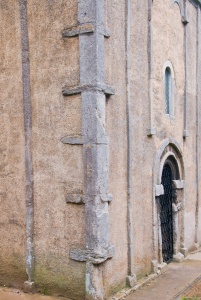
Saxon quoins
The lovely painted screen dates to the 15th century, though the painting was redone in 1935. The screen may have been brought here from another church after the original medieval screen at Earls Barton was removed during the English Reformation. It shows signs of weathering as if it were left outside during the move.
The screen is decorated with images of saints and, unusually, local butterflies. The butterfly is symbolic of resurrection, but their presence here is also a commemoration of a father-and-son pair of Victorian vicars of Earls Barton, the Knights, who were both avid lepidopterists.
The Chancel
The west end of the chancel is Norman, with lovely blind arcading. There is a 13th-century priest's door. The windows cover the gamut from Early English to Perpendicular Gothic. There are low windows on both sides of the chancel, probably to let the sound of the sanctus bell be heard clearly outside. Also in the chancel are 18th and 19th-century memorials to the Whitworth family, lords of the manor at Earls Barton.
Summing up All Saints
The pride of Earl's Barton deserves its reputation as one of the most sublime Saxon churches in England. The architecture of the tower is simply wonderful, and the interior deserves a visit all on its own. All Saints must rate as a 'must-see'.
The church is normally open during daylight hours.
About Earls Barton
Address: High Street,
Earls Barton,
Northamptonshire,
England, NN6 0JG
Attraction Type: Historic Church
Location: On the B573 between Northampton and Wellingborough
Website: Earls Barton
Location
map
OS: SP851638
Photo Credit: David Ross and Britain Express
HERITAGE
 We've 'tagged' this attraction information to help you find related historic attractions and learn more about major time periods mentioned.
We've 'tagged' this attraction information to help you find related historic attractions and learn more about major time periods mentioned.
Historic Time Periods:
Find other attractions tagged with:
15th century (Time Period) - Decorated (Architecture) - Norman (Architecture) - Saxon (Time Period) -
NEARBY HISTORIC ATTRACTIONS
Heritage Rated from 1- 5 (low to exceptional) on historic interest
Castle Ashby Gardens - 2.9 miles (Garden) ![]()
Castle Ashby, St Mary Magdalene Church - 2.9 miles (Historic Church) ![]()
Farndish, St Michael's Church - 5.6 miles (Historic Church) ![]()
78 Derngate - 6.2 miles (Historic Building) ![]()
Preston Deanery Church - 6.4 miles (Historic Church) ![]()
Northampton, St Peter's Church - 6.6 miles (Historic Church) ![]()
Rushden Hall - 6.6 miles (Historic Building) ![]()
Chichele College - 7.4 miles (Historic Building) ![]()















